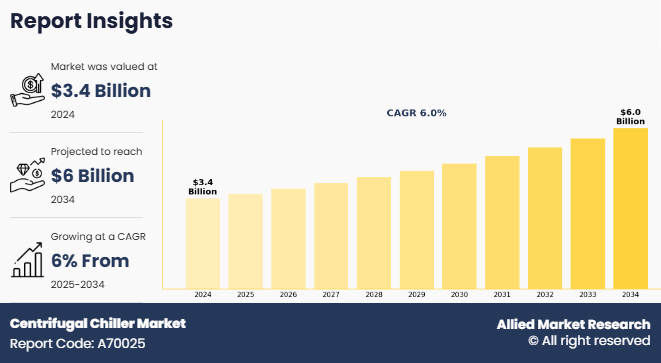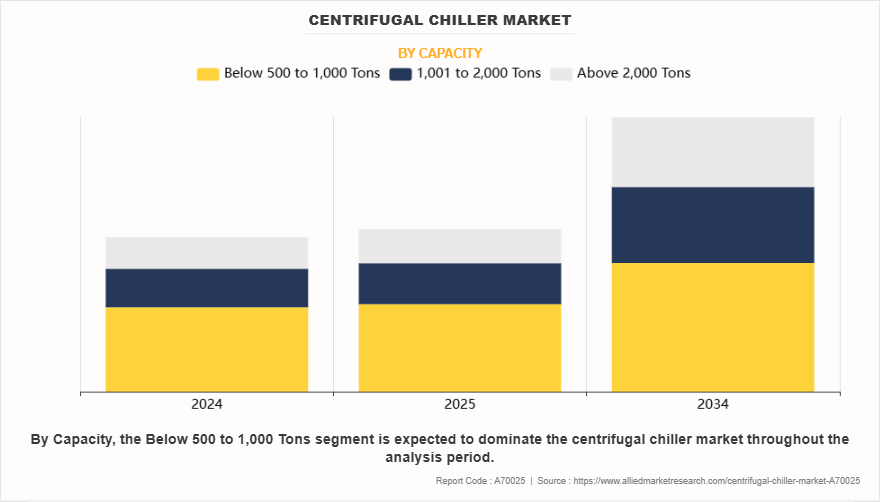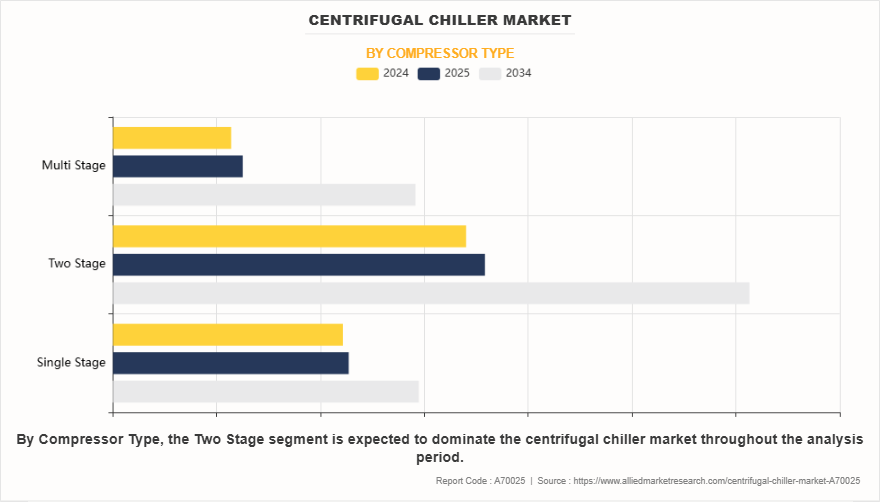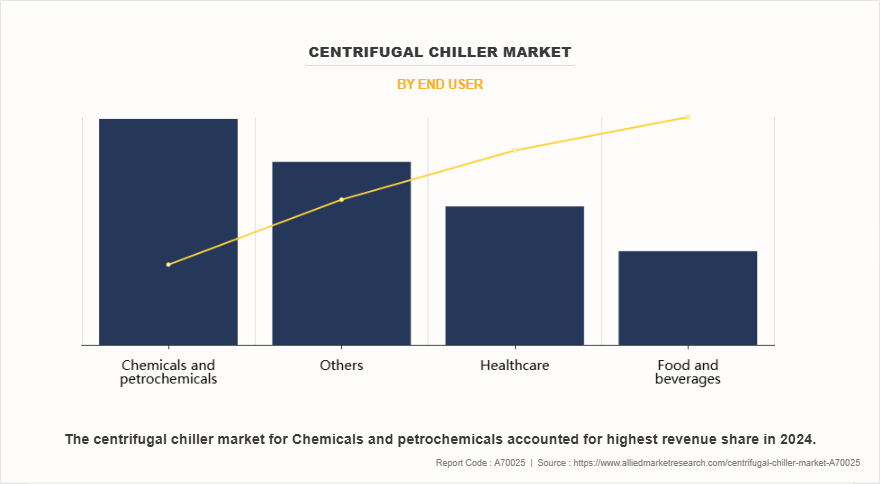Centrifugal Chiller Market Research, 2034
The global centrifugal chiller market was valued at $3.4 billion in 2024, and is projected to reach $6 billion by 2034, growing at a CAGR of 6% from 2025 to 2034.
Centrifugal chillers are large-capacity cooling systems used to provide chilled water for air conditioning and industrial processes. These chillers operate based on a centrifugal compressor that uses the principles of dynamic compression to accelerate and pressurize refrigerant vapor. The high-speed impeller increases the refrigerantânt velocity, thus transforming kinetic energy into pressure energy. This compressed refrigerant is then cooled in the condenser, allowing it to cycle back through the system to absorb heat from the chilled water loop.

The global centrifugal chiller market growth is fueled by factors such as rise in demand for energy-efficient HVAC solutions, rising construction sector and process cooling applications, and stringent environmental regulations encouraging the adoption of eco-friendly refrigerants. Technological advancements, including the integration of variable frequency drives (VFDs) and smart monitoring systems, along with the incorporation of smart technologies are further enhancing the efficiency and performance of centrifugal chillers.
The centrifugal chiller market is witnessing strong growth, largely driven by increasing attention toward energy efficiency and compliance with environmental regulations. As governments around the world introduce stricter norms to reduce energy consumption and greenhouse gas emissions, businesses are being encouraged to invest in advanced HVAC systems like centrifugal chillers. These systems offer higher efficiency and lower environmental impact compared to traditional cooling technologies, making them an attractive choice for both new installations and retrofits.
Another major factor supporting the market growth is the expansion of the construction industry and rising demand for process cooling across various industries. With new commercial buildings, hospitals, manufacturing plants, and infrastructure projects being developed globally, the need for reliable and large-scale cooling systems has increased. In industrial settings, process cooling plays a critical role in maintaining product quality and operational safety, further boosting the adoption of centrifugal chillers.
Technological advancements are also playing a crucial role in the evolution of the centrifugal chiller market. Modern centrifugal chillers are increasingly being equipped with smart features such as real-time monitoring, remote diagnostics, and energy optimization tools. These improvements help users reduce operational costs, enhance performance, and extend equipment life. As digital technologies continue to evolve, the integration of IoT and AI into HVAC systems is expected to become even more widespread, supporting smarter and more sustainable cooling solutions.
The centrifugal chiller industry also presents promising opportunities, especially with the rise of environmentally friendly refrigerants. As traditional refrigerants are being phased out due to their high global warming potential, manufacturers are introducing new models compatible with low-impact alternatives. This shift not only ensures compliance with environmental standards but also attracts environmentally conscious buyers. Furthermore, the growing reliance on data centers and IT infrastructure is creating a strong demand for precision cooling solutions. Centrifugal chillers, with their efficiency and capacity to handle large heat loads, are increasingly being used in such applications to ensure uninterrupted operation and protect sensitive equipment.
Despite these positive trends, the centrifugal chiller market does face some challenges. One of the primary restraints is the high initial investment and installation cost associated with centrifugal chillers. These systems require a significant upfront budget, which can discourage small and medium-sized enterprises from adopting them. In addition, installation often involves structural modifications and specialized setup, adding to the overall cost. However, many users recognize that the long-term savings in energy and maintenance can outweigh the initial expenses, especially when supported by incentives or green building certifications.
The centrifugal chiller industry plays a vital role in providing efficient cooling solutions for large-scale commercial, industrial, and institutional applications of the centrifugal chiller market. The centrifugal chiller market has been experiencing steady growth, driven by the increasing demand for energy-efficient systems in industries such as HVAC, manufacturing, and data centers. As businesses and institutions prioritize sustainable solutions, the centrifugal chiller market size continues to expand, with a strong emphasis on reducing energy consumption and improving operational efficiency. The centrifugal chiller market share is largely influenced by advancements in industrial chillers, HVAC chillers, and integration with building automation systems. With a positive centrifugal chiller market forecast, the industry is expected to grow further as technologies such as IoT sensors and variable speed drives are incorporated into new models. The centrifugal chiller market outlook remains optimistic, offering significant opportunities for innovations that address environmental and performance challenges. As the demand for sustainable, high-performance systems grows, the centrifugal chiller market opportunity becomes more pronounced, particularly in sectors like healthcare, manufacturing, and infrastructure development
The centrifugal chiller market is segmented into Capacity, Compressor Type and End User.

The global centrifugal chillers market is segmented based on capacity into below 500 to 1,000 tons, 1,001 to 2,000 tons, and above 2,000 tons. Among these, chillers with above 2,000 tons capacity lead the centrifugal chillers market share in 2024 due to their critical use in large-scale cooling environments such as petrochemical complexes, industrial plants, district cooling systems, and data centers. These chillers are essential for facilities that operate around the clock and require high-tonnage systems to maintain temperature stability. As the number of hyperscale data centers and mega infrastructure projects increases, especially in Asia and the Middle East, this segment is expected to continue shaping the centrifugal chillers market growth. Meanwhile, chillers in the 1,001 to 2,000 tons category are gaining rapid traction in mid- to large-scale commercial projects, offering a strong centrifugal chiller market opportunity for manufacturers. Their balance between performance and footprint makes them ideal for airports, shopping malls, and healthcare campuses, reflecting a rising centrifugal chillers market trend favoring flexible capacity systems.

The centrifugal chiller market is also segmented based on compressor type into single stage, two stage, and multi stage. Two-stage compressors currently dominate the centrifugal chillers market size in 2024 due to their reliability in steady load applications such as industrial cooling and large-scale process environments. However, the market is witnessing increased interest in multi-stage compressor systems, particularly in regions adopting advanced HVAC solutions. These systems provide superior energy control and are optimized for variable load conditions, which is becoming a key centrifugal chillers market trend. As industries focus more on reducing operating costs and meeting environmental targets, multi-stage systems are expected to drive significant centrifugal chillers market growth in the future. In contrast, single-stage compressors continue to cater to more basic or legacy cooling applications, but their growth is relatively limited as demand shifts toward more advanced solutions.

Based on end user, the centrifugal chiller market is segmented into chemicals and petrochemicals, food and beverages, healthcare, and others. The chemical and petrochemical segment remains the largest in terms of centrifugal chillers market share, primarily because of the high and continuous cooling demands of industrial processes. These facilities require robust systems that can operate in extreme conditions, making centrifugal chillers the preferred solution. However, the healthcare sector is quickly becoming one of the most promising areas in the centrifugal chillers market analysis. Driven by global healthcare infrastructure expansion, pharmaceutical manufacturing, and hospital upgrades, this segment is expected to contribute significantly to centrifugal chillers market growth. The food and beverage segment is also experiencing steady investment, particularly in areas related to cold storage and processing, while the ‐others‐ category, which includes commercial real estate and institutional buildings, benefits from urban development and sustainability efforts

Regionally, the centrifugal chiller market is segmented into North America, Europe, Asia-Pacific, and LAMEA (Latin America, Middle East, and Africa). Asia-Pacific held a significant portion of the centrifugal chillers market size in 2024 due to rapid industrialization, population growth, and hot climates that necessitate large-scale cooling systems. Government infrastructure projects, increased manufacturing output, and expanding commercial construction all contribute to this region's dominant centrifugal chillers market share. North America, meanwhile, shows steady growth fueled by retrofitting projects, technological upgrades, and early adoption of energy-efficient solutions. The centrifugal chillers market outlook in Europe is shaped by strong environmental regulations and incentives for sustainable cooling technologies. In LAMEA, particularly in Middle Eastern countries, the demand is growing rapidly due to harsh climatic conditions, ongoing hospitality investments, and construction of commercial hubs. These regional dynamics collectively support a strong centrifugal chillers market forecast over the coming years.
Further, the regional dynamics of the centrifugal chiller market are evolving significantly, shaped by technological adoption, climate demands, and infrastructure investment patterns. In Asia-Pacific, the market is witnessing strong momentum due to rapid urbanization, industrial expansion, and the development of large-scale infrastructure projects such as airports, metro systems, and smart cities. Countries like China, India, and Southeast Asian nations are actively investing in energy-efficient cooling solutions to support their growing commercial and manufacturing sectors. This regional demand aligns with the broader centrifugal chillers market trend toward sustainable and high-capacity HVAC systems. Meanwhile, North America continues to see demand driven by the replacement of aging infrastructure and a strong focus on energy optimization and green building certifications. In the U.S. and Canada, data center expansion and smart hospital projects are key contributors to centrifugal chillers market growth.
Europe is progressing steadily with strict regulations aimed at lowering greenhouse gas emissions, encouraging industries to adopt chillers that use low-GWP refrigerants and advanced compressor technologies. This has bolstered innovation and increased market opportunity for energy-efficient centrifugal systems. On the other hand, the LAMEA region especially the Middle East is experiencing accelerated growth due to climate conditions that require constant cooling, coupled with high-value real estate and hospitality developments in cities like Dubai and Riyadh. As these regions compete to become tourism and business hubs, centrifugal chillers are vital for maintaining ambient conditions in large venues and luxury establishments. Overall, regional investments, sustainability goals, and climate-specific needs are shaping a robust centrifugal chiller market outlook globally
Competition Analysis
The centrifugal chiller market profiles major market players, including Johnson Controls, Trane Technologies plc, Daikin, Haier, Midea, Smardt Chiller Group, Inc., Carrier, Mitsubishi Heavy Industries, Ltd., LG Electronics, and TopChiller.
Key Benefits For Stakeholders
- This report provides a quantitative analysis of the market segments, current trends, estimations, and dynamics of the centrifugal chiller market analysis from 2024 to 2034 to identify the prevailing centrifugal chiller market opportunities.
- The market research is offered along with information related to key drivers, restraints, and opportunities.
- Porter's five forces analysis highlights the potency of buyers and suppliers to enable stakeholders make profit-oriented business decisions and strengthen their supplier-buyer network.
- In-depth analysis of the centrifugal chiller market segmentation assists to determine the prevailing market opportunities.
- Major countries in each region are mapped according to their revenue contribution to the global market.
- Market player positioning facilitates benchmarking and provides a clear understanding of the present position of the market players.
- The report includes the analysis of the regional as well as global centrifugal chiller market trends, key players, market segments, application areas, and market growth strategies.
Centrifugal Chiller Market Report Highlights
| Aspects | Details |
| Market Size By 2034 | USD 6 billion |
| Growth Rate | CAGR of 6% |
| Forecast period | 2024 - 2034 |
| Report Pages | 229 |
| By Capacity |
|
| By Compressor Type |
|
| By End User |
|
| By Region |
|
| Key Market Players | Haier, TopChiller, Trane Technologies plc, Carrier Corporation, MITSUBISHI HEAVY INDUSTRIES, LTD., Johnson Controls, Smardt Chiller Group, Inc., LG Electronics, Midea, Daikin |
Process cooling in industries such as chemicals, petrochemicals, food and beverages, and pharmaceuticals is the leading application segment. These sectors require consistent and large-scale cooling solutions for operational efficiency and compliance with safety standards. The healthcare industry is also rapidly emerging as a major application area due to increasing investments in hospital infrastructure, especially post-pandemic, where climate-controlled environments are essential for patient safety and medical equipment performance.
Asia-Pacific holds the largest share of the centrifugal chiller market, owing to its fast-growing industrial base, urban infrastructure expansion, and rising demand for commercial cooling solutions. Countries like China and India are at the forefront due to increasing investments in smart cities, manufacturing hubs, and transport infrastructure. The region also benefits from a surge in data centers and commercial real estate development, which are key end users of high-capacity centrifugal chillers.
The centrifugal chillers market is poised for steady growth through 2034, supported by increasing infrastructure development, climate change-related cooling needs, and technological enhancements. The market size is expanding due to growing adoption across both mature and emerging economies, with a notable rise in demand from data centers, hospitals, and high-rise buildings. Strong policy push for energy efficiency and the replacement of older, less efficient systems are further contributing to market expansion.
The centrifugal chiller market is experiencing significant transformation driven by the rising emphasis on energy efficiency, integration of smart HVAC technologies, and the adoption of eco-friendly refrigerants. Market trends also show a shift toward modular and scalable chiller designs, suitable for evolving demands in sectors such as data centers, healthcare, and industrial processing. Additionally, the push toward net-zero carbon emissions is accelerating demand for centrifugal chillers that offer low-GWP (Global Warming Potential) refrigerants and compatibility with renewable energy-powered cooling systems.
Some of the major players dominating the centrifugal chillers market share include Johnson Controls, Trane Technologies plc, Daikin, Carrier, Mitsubishi Heavy Industries, Ltd., LG Electronics, Haier, Midea, Smardt Chiller Group, Inc., and TopChiller. These companies are continuously investing in product innovation, expanding their global footprint, and integrating digital solutions to strengthen their competitive positioning in the centrifugal chillers market.
Loading Table Of Content...
Loading Research Methodology...



